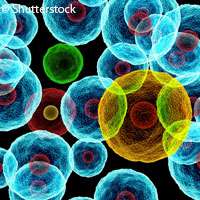Scientists identify how cells respond to mechanical force

Many aspects of cell behaviour are influenced by mechanical force, but how single cells respond to these forces is unclear. An EU-funded team of researchers sheds light on the relationship between the signals that affect cells' behaviour and their physical properties. The findings are published in the journal Nature Cell Biology.
Biologists and physicists led by the University of North Carolina at Chapel Hill (UNC-Chapel Hill) in the United States found that exerting mechanical force on cells activates Rho-GEF proteins through distinct signalling pathways. According to the researchers, these Rho proteins are members of the Ras superfamily, a class of proteins linked to cancer activity. The team exerted force on the cells by using magnets and applying magnetic particles to the cells. This generated extracellular tension.
"The application of force on integrins triggers cytoskeletal rearrangements and growth of the associated adhesion complex, resulting in increased cellular stiffness, also known as reinforcement," the authors write. "Although RhoA has been shown to play a role during reinforcement, the molecular mechanisms that regulate its activity are unknown. By combining biochemical and biophysical approaches, we identified two guanine nucleotide exchange factors (GEFs), LARG and GEF-H1, as key molecules that regulate the cellular adaptation to force. We show that stimulation of integrins with tensional force triggers activation of these two GEFs and their recruitment to adhesion complexes."
Commenting on the success of the study, senior author Professor Keith Burridge, a researcher of cell and developmental biology at UNC-Chapel Hill, says: "This experiment was only possible because we were able to bring together a team of physicists and cell biologists. It's very exciting because we have identified the entire pathway between the tension exerted on the cell to proteins that, in turn, activate other proteins that we know tend to be hyperactive in cancer."
Past studies postulated that the mechanical environment of cells impacts cell growth and properties. Solid tumor cells usually have an altered stiffness, for instance. Other studies discovered that the prognosis gets worse when the cell matrix becomes stiffer. Scientists have also proved that rigid tumours shed an increased number of cells, and they in turn escape the original tumor site, which potentially raises the risk of cancer spreading through metastasis.
"There has been a hypothesis that cell stiffness and tension create a vicious cycle leading to enhanced growth, more cell density, more tension, and larger tumors," Professor Burridge explains.
He goes on to say that the funding afforded to the researchers, including a grant from the University Cancer Research Fund in the United States, gave the team the support they needed to obtain their results. More work on this issue is planned by the researchers, helping to further elucidate the association between the signals that impact both the behavior and physical properties of cells.
More information: Guilluy, C., et al. (2011) 'The Rho GEFs LARG and GEF-H1 regulate the mechanical response to force on integrins'. Nature Cell Biology. DOI: 10.1038/ncb2254
Provided by CORDIS














